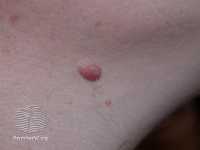
14 Aug Genetics Plays A Key Role in Where Moles Develop on Skin
MedicalResearch.com Interview with:
Dr Alessia Visconti, PhD
Department of Twin Research
King’s College London,
London
MedicalResearch.com: What is the background for this study?
Response: We know from previous studies that the body site where melanoma skin
cancer develops varies according to sex, with men having melanoma more
often on the head, neck, and trunk, and women on the legs.
The body site where moles, a major risk factor for melanoma development,
are more abundant also varies according to sex, at least in childhood,
with boys having more moles on the head, neck, and trunk, and girls on
the legs.
MedicalResearch.com: What are the main findings?
Response: In our study, we first confirmed that, in adulthood, moles are still
more abundant on the head, neck, and trunk in males, and on the legs in
females.
Then, we used two different approaches to show that this pattern of mole
development, at least in women, is strongly depends on our genetic make
up. Unfortunately, our cohort did not have enough measurements in men to
confirm these observations in them.
MedicalResearch.com: What should readers take away from your report?
Response: We showed that genetics plays an important role on where moles, and most
likely, also melanomas, develops. This also challenges the idea that
women have more moles on the legs only because they have a higher sun
exposure at this site.
MedicalResearch.com: What recommendations do you have for future research as a result of this work?
Response: Further research will be needed to confirm a similar effect in men. Our
findings suggest that future studies should take the sex of the patient
and the body site where moles and melanoma develop into consideration
because they are likely to play an important role.
No disclosures.
Citation:
Visconti, A. , Ribero, S. , Sanna, M. , Spector, T. D., Bataille, V. and Falchi, M. (2019), Body site‐specific genetic effects influence naevus count distribution in women. Pigment Cell Melanoma Res. Accepted Author Manuscript. doi:10.1111/pcmr.12820
[wysija_form id=”3″]
[last-modified]
The information on MedicalResearch.com is provided for educational purposes only, and is in no way intended to diagnose, cure, or treat any medical or other condition. Always seek the advice of your physician or other qualified health and ask your doctor any questions you may have regarding a medical condition. In addition to all other limitations and disclaimers in this agreement, service provider and its third party providers disclaim any liability or loss in connection with the content provided on this website.
Last Updated on August 14, 2019 by Marie Benz MD FAAD

